Transportation Triage
at the end of the age of oil
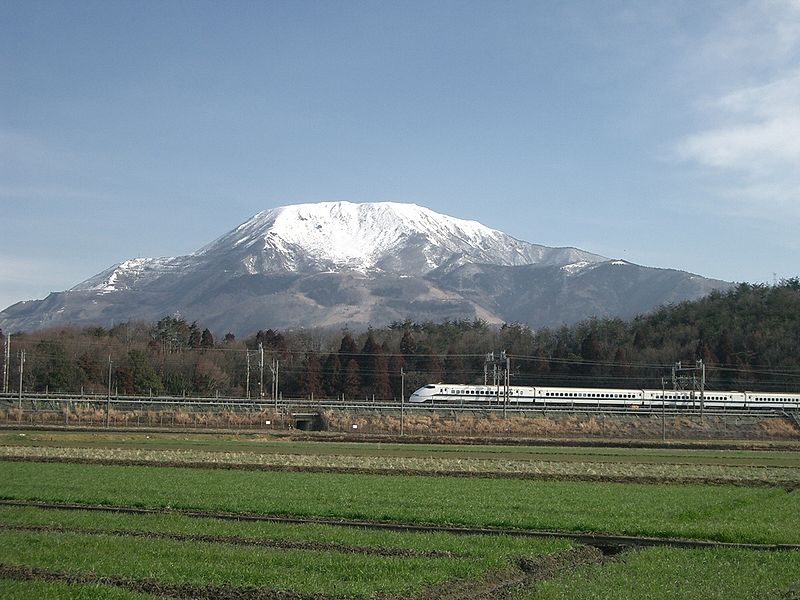
Bullet train, Japan
This presentation highlights choices that are going to be forced on all levels of government as the cheap oil is replaced by expensive oil.
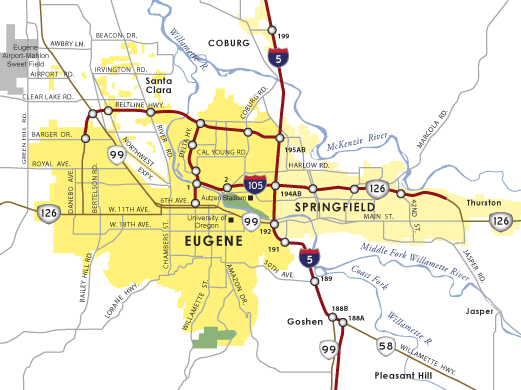
The City of Eugene, Lane County, the State of Oregon and the Federal government are all united in promoting major increases in highway funding. This expansion has bi-partisan support, both Democrats and Republicans want to build more and more highways, although the Democrats generally want more highways and more transit systems, while most Republicans only favor new roads without the transit improvements.
Representative Peter DeFazio is on the Transportation Committee, and claims that building new road capacity will help us solve the climate crisis. In reality, road construction burns lots of fossil fuels, and the claim we need more roads to reduce air pollution is propaganda to justify highway bailouts. DeFazio told KLCC’s audience on January 4 that he didn’t know of any major widening project planned on Interstate 5, although two of them are walking distance from his home in Springfield -- the I-5 / Beltline interchange and plans for a wider bridge across the Willamette River.
In November 2007, Mayors Piercy and Leiken joined forces to pass a Regional Transportation Plan containing $817 million for road expansions through the rest of the oil age. This plan gave the Cities the right to ask Congress for earmarks for planned highway projects such as the widening of I-5, Beltline and Route 126 in Springfield. Last September, Lane County asked ODOT to allocate $186 million in near term requests to implement this plan, the vote was 4 to 1 in favor. Governor Kulongoski is now urging the legislature to appropriate an immediate short term infusion of a half billion dollars to expand road projects -- his Oregon Transportation Commission chair also claims that building bigger roads will help solve the climate crisis.
Peak Traffic
Peak Oil
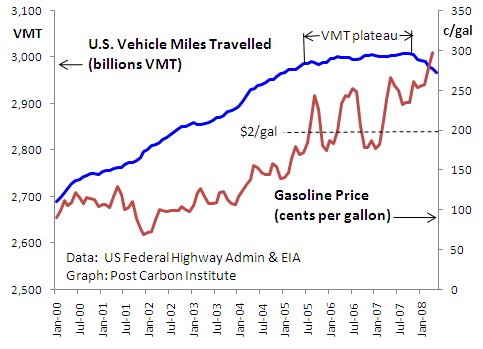
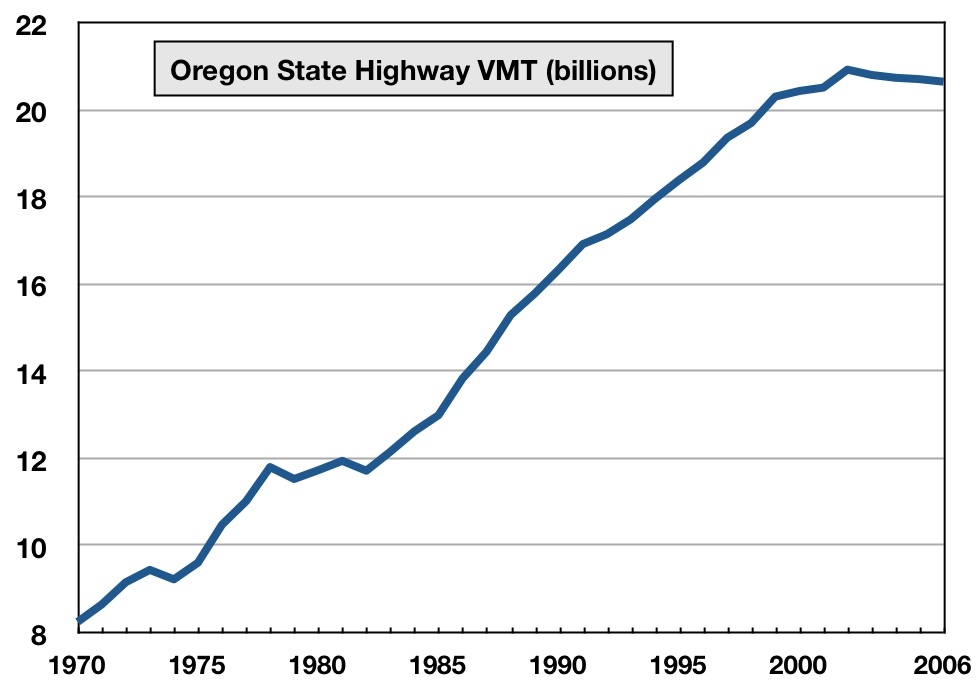
Most people have now heard of the concept of Peak Oil, but there is still not much public awareness of the implication and virtually no official response to the crisis. Peak Oil does not mean that the oil has run out, it merely is the point where oil extraction rates can no longer be increased no matter how much effort is expended. The end of the growth of fossil fuel use has tremendous implications for every aspect of civilization - they are beyond the scope of this short presentation - but it is safe to say that how we manage the downslope of petroleum is the most critical task facing our species. How will we use the rest of the oil - to help prepare future generations for living without any oil, or to pretend that business as usual will remain possible. Technological changes for efficiency will be useful, but they will not be sufficient to cope with the scale of these problems.
The Peak Oil curve mirrors the rise of Vehicle Miles Travelled on our highways, even showing temporary decreases after the 1973 Saudi oil embargo and the 1979 Iranian revolution. But the current leveling off of traffic levels is a permanent condition, since on the downslope of oil production there will be less energy available for transportation, and a diminished economy capable of sustaining this level of activity. Even a more rapid introduction of hyper efficient cars or electric vehicles will merely change the slope of the Peak Traffic downslope, since it takes a long time to convert existing infrastructure, it takes a lot of energy to make the alternative technologies, and we should have done this decades ago for the transition to be painless.
Transportation Triage:
how to use finite funds


As we enter the Peak Oil downslope, we will find ourselves in a world with much less concentrated wealth - which forces us to make choices.
Lane County is promoting a concept to increase highway construction funds by taxing people for the number of miles they drive. This seems reasonable on the surface, but it would tax those who drive efficient cars at the same rate as SUVs, discouraging energy efficiency. People who drive gently and use less gas would pay the same rate as speeders. Worse, to ensure that only miles driven in Oregon would be charged, all cars would have to be fitted with surveillance devices to keep track of everyone’s travels. Government officials promise that no records would be kept of this information, but if you believe that I have a broken bridge to sell you.
Troubled Bridges Over Water
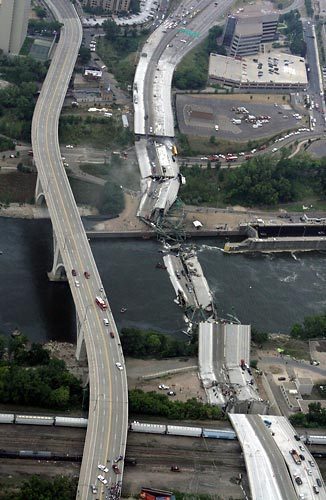
The nation was shocked in 2007 when the eight lane Interstate 35 suddenly plunged into the Mississippi River in Minneapolis. But this was not the first time a major bridge collapse killed travelers, and it’s unlikely to be the last time. Tens of thousands of highway and rail bridges across the country are worn out, rusting, frayed from too many trucks and freight trains. Oregon has numerous broken bridges along I-5, I-84 and many other routes, but has only had funding to fix some of them.
Locally, replacement of the cracked I-5 Willamette River Bridge is in the queue, but ODOT and local governments hope to use this replacement as an opportunity to widen the highway - just as we are passing the end of cheap oil and the start of climate change. Replacing cracked bridges with new bridges OF THE SAME WIDTH would save tax dollars that could be used to fix more dangerous structures. None of the bridges built in Oregon during the construction of the interstate highways were built with any seismic safety concerns, and most will probably fall down when a large earthquake finally happens. Public safety requires that expansion plans be canceled in favor of maintenance.
Amtrak upgrades for Cascadia
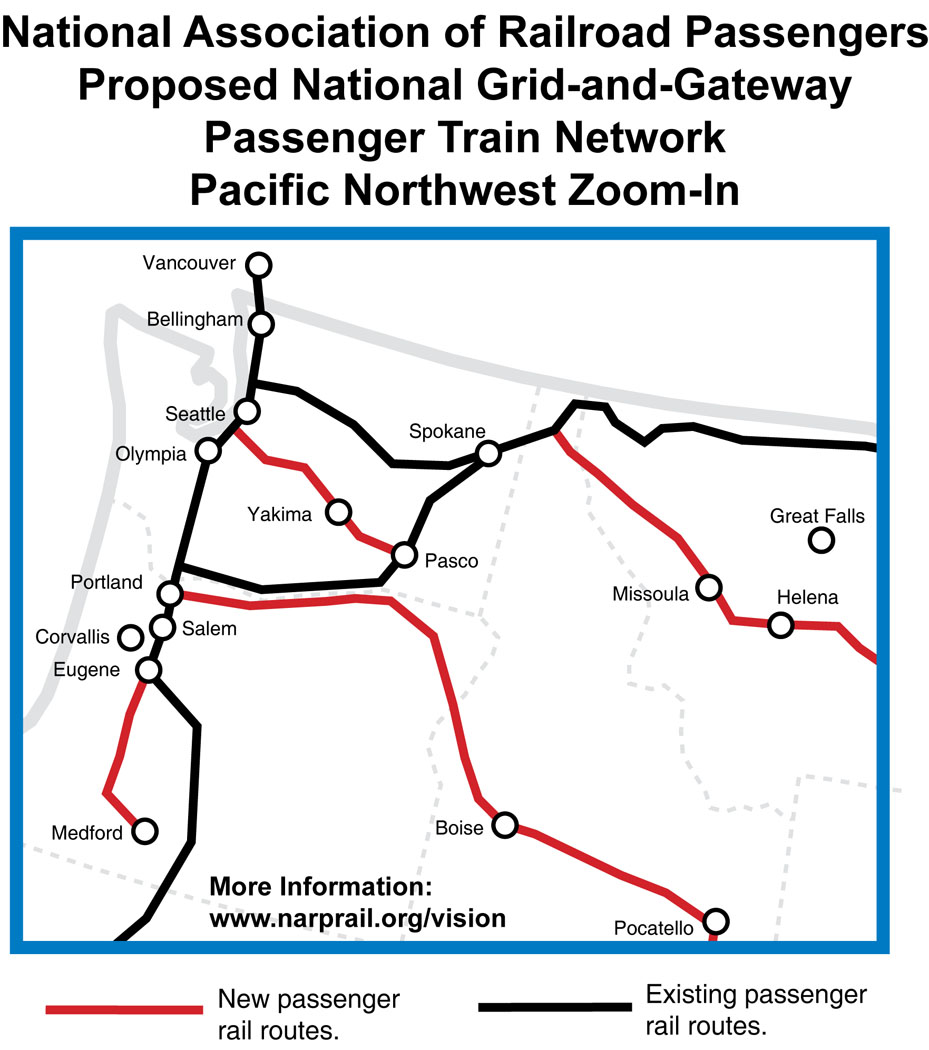
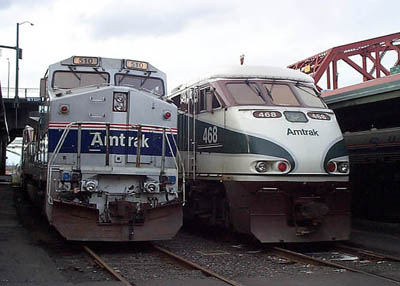
Coast Starlight - 79 mph
Amtrak Cascades - 124 mph
Money planned to widen I-5 and other highways could instead be used for transportation systems that will be more useful when oil supplies decline. This map shows a proposal from the National Association of Railroad Passengers to revive intercity train routes, especially the Portland - Boise - Salt Lake line that was canceled in the late 1990s. Washington State is spending some money to improve speeds on the Amtrak Cascades route from Portland to Seattle and Vancouver, B.C., but the State of Oregon is not. The Amtrak Cascades locomotives can travel up to 124 miles per hour - 200 kilometers per hour - but the tracks are in such poor shape that it takes longer to take the train from Eugene to Portland than to drive on I-5 at 55 mph -- assuming that the train is running on time. The trains have to slow down to about 30 mph to cross the Willamette River between Junction City and Harrisburg because that rail bridge is worn out and needs replacement. Ideally, a parallel, passenger only track is needed for faster train service, but widening I-5 is what the Oregon Department of Transportation and local governments have prioritized.
proposed national high speed rail network:
the price: about the cost to destroy Iraq
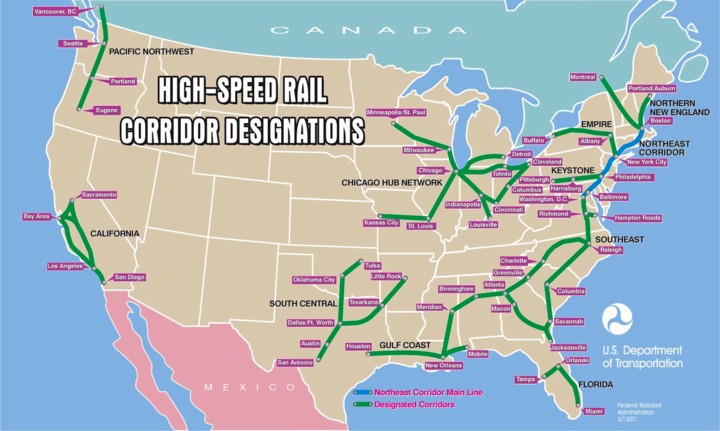
The money we’ve spent to destroy Iraq could have been used for renewable energy systems to power a real national rail network
this is a proposal from the US Dept of Transportation - but of course it’s not a priority of most Democrat or Republican politicians. (Most political speeches that argue for “freedom from imported oil” fail to use the word “Amtrak.”)
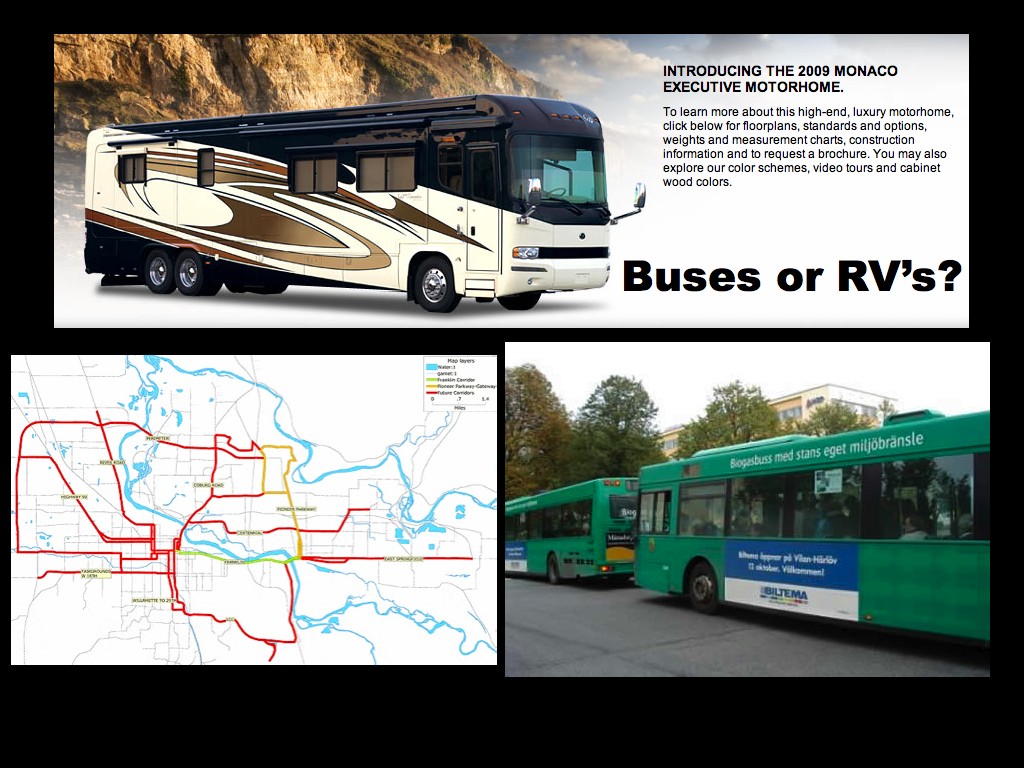
Our region has received some national attention for its Bus Rapid Transit line between Eugene and Springfield. The map on the left shows Lane Transit District’s proposal for a regional network of BRT routes running on dedicated right of way. However, LTD is also proposing major cuts to existing service while planning the speedy bus service. The fancier buses will not be as useful if the current routes are cut back, since many people will still need a local bus to get home, especially when the ultimate BRT network remains a pipe dream.
Two economic initiatives that could be implemented, if there was sufficient vision. Lane County is home to RV manufacturing facilities that are likely to be economic casualties of the financial crash and ultimately of Peak Oil. These factories could be converted to make public transit systems for our region and for export.
Another initiative is to use biogas from the Eugene municipal sewer waste system to run our transit services - the photo on the right is of a biogas powered bus in Sweden.
Lowe's / Wal-Mart photos
Any transportation planning needs to be tightly coupled with land use policies to be effective at reducing congestion. Perhaps the most dysfunctional urban design is allowing big box chain stores to dominate the landscape. These facilities wreck our local economy by exporting capital and undermining local business. Big box store designs are the most car dependent, are hard to serve with public transit, and are ugly. Many cities have restricted or banned big box stores, including Hood River, Oregon, whose ban on very big stores was upheld by the Oregon Supreme Court. Sadly, Eugene has declined to follow their leadership - even the Kitty Piercy administration has not done this.
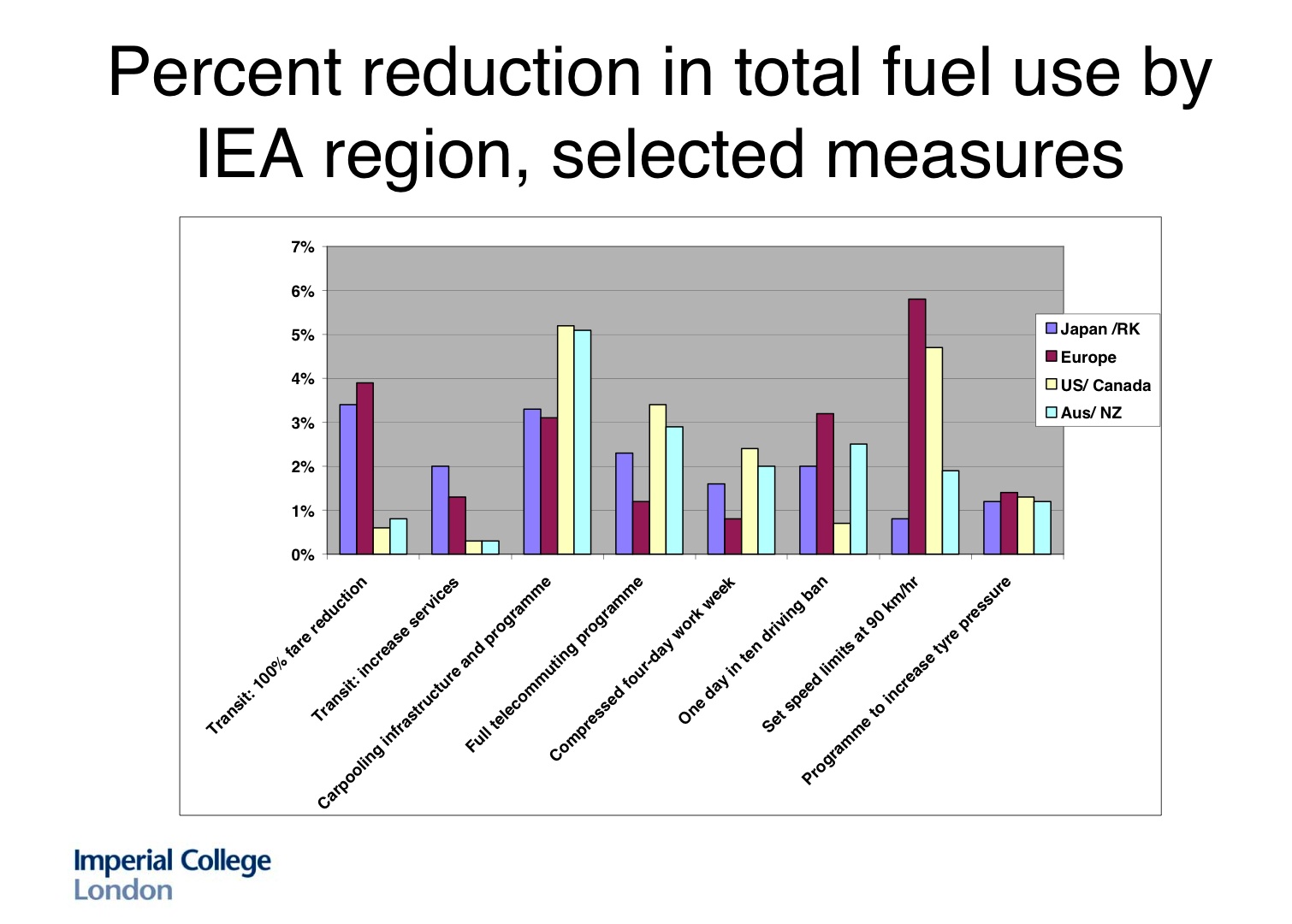
In 2005, the International Energy Administration prepared a report for member countries called Saving Oil in a Hurry. It was an effort to determine ways to cope with a sudden reduction in oil availability, since there are many technical and political scenarios that could result in less petroleum -- collapse of a major oil field, war on Iran, terrorist attack on oil facilities. This chart is complex, but in summary it states that for the US the most effective tools would be carpooling and lowering speed limits to 90 kilometers per hour -- 55 mph. Reducing speed on the highways would save more energy than the daily flow through the Alaska Pipeline, an easy step to take if we ever get serious about conservation - whether through voluntary efforts or if these choices are forced upon us by external circumstance.
All of these charts are posted on line at www.sustaineugene.org - along with background material.
Thank you for your attention and concern.